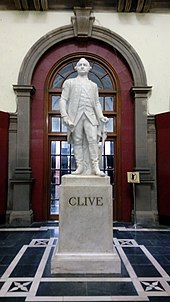Statue of Robert Clive, London
| Statue of Robert Clive | |
|---|---|
Robert Clive, 1st Baron Clive | |
| Location | King Charles Street, London SW1 |
Listed Building – Grade II | |
| Official name | Statue of Clive on steps at west end |
| Designated | 14 January 1970 |
| Reference no. | 1221431[1] |
A Grade II-listed bronze statue of Robert Clive, 1st Baron Clive, by John Tweed, stands in King Charles Street, Whitehall, London.[2] The work was unveiled in 1912 outside Gwydyr House, also in Whitehall, and was moved to its current location in 1916.[3][2][1]
Description
On the west face of the plinth are Clive's surname and the year of his birth and death (1725–1774).[4] The remaining three sides have bronze reliefs depicting events in his life: the Siege of Arcot in 1751, the eve of the Battle of Plassey in 1757 and the Treaty of Allahabad in 1765.[4]
History
On 8 February 1907,
John Tweed was commissioned to start work on the London statue and exhibited a sketch model at the Royal Academy in 1910.[11] The statue was unveiled in a temporary location in Gwydyr Street in 1912.[12] It was moved to its permanent location in 1916.

The statue is placed on a high plinth, inlaid with bronze bas-relief on three sides, depicting three historic scenes associated with Clive's career in India. The scenes are: the siege of Arcot, the Battle of Plassey 1757 and the Grant of Diwani by the Mughal emperor to the British East India Company, represented by Clive, in 1765.

A smaller version of the finished statue, also cast in bronze, is now part of the collection of the Tate in London.[11] Other works by Tweed portraying Clive include a memorial tablet in the south choir aisle of Westminster Abbey, erected by public subscription in 1919,[13] and a marble statue at the Victoria Memorial in Kolkata, India.[14]

21st century
At the beginning of the 21st century, the statue was singled out for criticism by Nick Robins in his history of the East India Company, The Corporation that Changed the World. In the book, he argued that "the fact that one of Britain's greatest corporate rogues continues to have pride of place at the heart of government suggests that the British elite has not yet confronted its corporate and imperial past." The book concluded by calling for the statue to be removed to a museum.[15]
In June 2020, calls were made for the statue's removal after a
See also
- Bali Bombings Memorial, London, located nearby
References
- ^ a b Historic England. "Statue of Clive on steps at west end (1221431)". National Heritage List for England. Retrieved 26 September 2014.
- ^ a b "Statue: Lord Clive". London Remembers. Retrieved 26 September 2014.
- ^ "Statue of Lord Clive". Discovery. The National Archives (United Kingdom). Retrieved 26 September 2014.
- ^ a b "Robert Clive – London, UK – Statues of Historic Figures". Waymarking. Retrieved 26 September 2014.
- ^ a b "The campaign to remember Clive of India". Shropshire Star. 27 May 2011. Retrieved 26 September 2014.
- ISBN 978-1-84631-691-3
- ^ Curzon. (13 August 1907). "Clive Memorial Fund". The Times.
- ^ Ward-Jackson 2011, pp. 109–110.
- ^ Dalrymple, William (11 June 2020), "Robert Clive was a vicious asset-stripper. His statue has no place on Whitehall", The Guardian, retrieved 11 June 2020
- ISBN 978-0141990866.
- ^ a b "John Tweed Lord Clive c.1910–12". Tate. Retrieved 26 September 2014.
- ^ "Robert Clive (1725–74) | Statue by John Tweed, 1912". English Heritage. Retrieved 4 February 2024.
- ^ "Robert Clive". Westminster Abbey. Dean and Chapter of Westminster. Retrieved 26 September 2014.
- Victoria Memorial (India). Retrieved 26 September 2014.
- OCLC 820849779.
- ^ a b "The Londoner: Now Clive of India is a monumental problem", Evening Standard, 9 June 2020, retrieved 11 June 2020
- ^ Bland, Archie (10 June 2020), "After Colston, figures such as Drake and Peel could be next", The Guardian, retrieved 11 June 2020
- ^ Andrew Simms (10 June 2020). "Reckoning with Britain's imperial legacy: time to search for new heroes". New Weather Institute. Retrieved 20 June 2020.
External links
 Media related to Statue of Clive of India, London at Wikimedia Commons
Media related to Statue of Clive of India, London at Wikimedia Commons- English Heritage webpage on the statue
